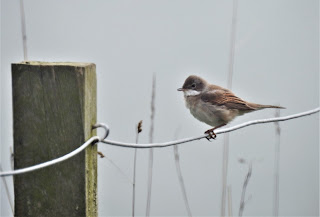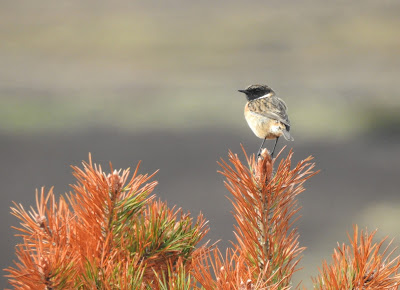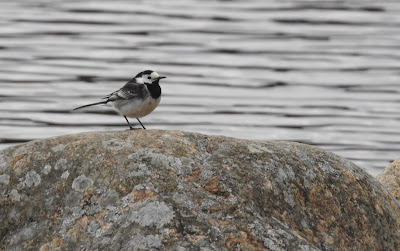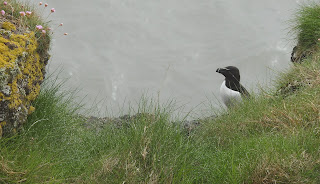May 2022 was a pretty decent month for wildlife watching in this area weather-wise. It was relatively calm throughout , often sunny, with just a few windy or wet days towards the end , and no real extremes experienced - which was a bit of a relief , as it's always the best, and my busiest month of the year for safaris.
With around 18 hours of usable daylight, and all of our summer visiting birds arrived by mid-month, our local full-day bird species day-lists climbed ever higher, with 50+ species a regular occurrence, and the early starts - when mammals are more active - (now 4am or earlier) for the Black Grouse 'leks', also helped us to see up to 8 different mammals in a day too!!
With the 'dawn chorus' still in full swing, the wild flowers in full bloom, and butterflies, bees and other insects on the wing, a day out in the wilds, visiting a huge variety of habitats, in May in this area really could honestly be described as a 'whirlwind of wildlife'
A few day-trips further afield to various favourite places, including the Isle of Mull, and RSPB Fowlsheugh , gave me my annual 'fix' of seabirds , including Terns, sea ducks and Auks including Puffins, and some decent raptor and mammal sightings.
 |
| Spring at a picturesque local loch |
To give you an idea of what you may realistically hope to see if you are considering a future May visit, I hope the following more detailed information, illustrated with photos taken at sites in and around the Cairngorms National Park by myself, my friends or my safari clients this month and in previous May's will help....clicking on the picture enlarges it to full-screen.
Local speciality/upland bird species seen regularly during the month included:
Black Grouse (at or soon after dawn only), Red Grouse, Osprey, Ring Ouzel, Slavonian Grebe, Red-Throated Diver, Black-Throated Diver, Goldeneye and Dipper, with a chance of Wood Warbler and Pied Flycatcher...
We also had a few decent local sightings of Golden Eagle and White-Tailed Eagle - usually sub-adult birds, though, as is normal for this time of year, they are definitely getting harder to see...
It should be noted that, due to their very secretive and almost silent nature at nesting time , Crested Tits continue to be extremely difficult to see during their breeding season (April-May), and we usually struggle to see them until they fledge their young late in the month....and Crossbill sightings, are usually largely restricted to brief fly-over glimpses...
With the snow largely restricted to the mountain tops by May, that's where you have to go to have a chance of seeing Snow Bunting, Ptarmigan (and from mid-month) Dotterel....please be aware that this would usually take a good part of a day, and a lot of strenuous hill walking to achieve, and would need to be a separate adventure from a 'normal' safari excursion.....
Summer migrant birds continued to flood in throughout the month, with Common Swift, Spotted Flycatcher, Pied Flycatcher , Wood Warbler, Common Whitethroat, Sedge Warbler, and Whinchat, joining Wheatear, Common Sandpiper, Sand Martin, House Martin, Swallow, Willow Warbler, Chiffchaff, Blackcap, Redstart, and Tree Pipit, to name just a few....
Mammal species seen regularly included:
Rabbit, Brown Hare (mainly very early in the day) , Red Squirrel, Red Deer, Roe Deer, Reindeer, and feral Mountain Goat, with just a couple of views of Mountain Hare (now a mottled blue-grey), and we also had a few sightings of Sika Deer, and one brief glimpse of a Bank Vole....Whilst trips to the coast usually provided both types of Seal.
May 2022 bird sightings in more detail:
On the lochs...
 |
| A local loch |
 |
| A pair of Ospreys in their impressive nest |
 |
| Osprey with a fish |
 |
| Nesting material delivery |
 |
| Osprey with a good sized trout |
Our local Ospreys continued to entertain and excite my safari clients, often being voted as 'Bird of the day', though it should be noted that, with the female birds spending much of the month deep in their nests incubating eggs with just their heads visible, and later in the month, brooding young, sightings could be a bit frustrating, as we needed a bit of luck to coincide our visit with the male birds being 'at home' or delivering a fish or more nest-building materials.....though we did also see birds fishing local lochs and rivers on a few occasions...one bird 'seeing-off' an intruding Common Buzzard, and sometimes we even witness a successful 'plunge-dive'!! always a treat....
 |
| Red-Throated Divers |
 |
| Red-Throated Diver |
 |
| Black-Throated Divers |
 |
| Black-Throated Diver by Chris Ballance |
 |
| Slavonian (Horned) Grebe by Ian Dennis |
 |
| Slavonian (Horned) Grebe |
Slavonian Grebe, Red-Throated Diver and Black-Throated Diver UK-wise, are only usually found breeding, and in their dapper summer plumage, on suitable secluded lochs in northern Scotland and it's islands, and we are very fortunate to get a handful of nesting pairs locally. Though the Slavonian Grebes can be quite obliging, due to the Divers' general wariness of humans, most of the views we get of them are through a scope at a fair distance, and any decent ripple on the water makes finding them very difficult to find, but on a few occasions, and with a little persistence, we got lucky and obtained a slightly closer look, without risk of disturbing them, and even managed a few rare photo opportunities....
 |
| Female Goldeneye with cute youngsters (photo from May 2020) |
 |
| Male Goldeneye |
The same could be said of our Goldeneye, with this attractive tree-nesting duck (yes, really!!) being a north of Scotland breeding speciality too, and late in the month we often get to see a few females with their ridiculously cute youngsters too... nice!
Goosanders too, are a bit of a northern/upland UK speciality, and we managed a few decent sightings this month.
Up on the moors....
 |
| A local upland heather moorland |
 |
| Lekking Black Grouse |
 |
| Lekking Black Grouse |
Black Grouse 'lekking' is surely one of British wildlife's top 10 sights (and sounds), and our local birds continued to 'perform' throughout the month, with up to 8 cock birds seen fighting it out, though usually not quite as vigorously as in April, except for when female birds were seen 'checking out' the lek, though with dawn at around 4 am, and the performance only lasting for around 90 minutes on average, it should be noted that a very early start is needed if you want to see them...and please be aware that we have to view from a respectful distance to avoid disturbance........but with a quality spotting scope, this is still a highly recommended and memorable experience, especially as on a few occasions whilst watching the lek, we can have a supporting cast of hunting raptors, displaying Curlew and Snipe and calling Cuckoo, and up to 5 different mammal species including Mountain Hare , all in the first hour and a half of daylight!!
Please note though, that by the end of May the Black Grouse lekking season is usually over, with the birds seemingly losing interest, numbers at the lek decreasing, and them then generally 'disappearing' until the winter....
 |
| Male Red Grouse by Ian Dennis |
 |
| Female Red Grouse by Ian Dennis |
 |
| Male and female Red Grouse by Chris Ballance |
Also on our local upland heather moorlands, the much more common and 'birder-friendly' Red Grouse continued to show well, with some cock birds even still displaying and calling whilst defending their territory and nesting female, their guttural 'go bak go bak' calls echoing across the moor, and late in the month we began to see the hen birds with their newly fledged families of very cute fluffy youngsters...
 |
| Short-Eared Owl |
Still on the moorlands, we occasionally see birds of prey taking advantage of the abundant prey items to be found there, with the raptor highlight this month, being a splendid Short-Eared Owl.
In the Caledonian forests...
 |
| Early morning in an ancient Caledonian forest |
 |
| Crested Tit by Paul Hodgson |
Crested Tit sightings are usually very difficult to obtain in May, with the birds nesting very secretively, rarely visiting feeders, and only occasionally heard singing or calling. To give you an example, one May we spoke to a party of birders who had spent 10 hours one day, walking round several local pine forests without a hint of a sighting...though with a lot of persistence, we can sometimes manage a glimpse, though you really do need to be familiar with their distinctive calls and song...
 |
| Female Crossbill |
 |
| Male Crossbill |
Continuing the forest theme, Crossbills are all too often the cause of much frustration on my safaris, with me regularly hearing their distinctive 'jip' jip' jip' calls overhead, and my safari clients getting just a brief glimpse of the birds flying away, usually never to be seen again! But occasionally they can actually be more obliging, with us getting some good views, sometimes even through the scope, of family parties feeding together on pine cone seeds, giving us the chance to admire the brick-red males, greeny-yellow females and streaky youngsters, Photographic opportunities are usually a rare occurrence though...
As is usual, we failed to manage any sightings of Capercaillie this month, though we did find a Caper poo on one of our forest walks...
Please note: In order to help protect them and keep sensitive sites 'off the radar', I no longer take clients on specific Capercaillie-hunting missions, and although we do visit suitable areas of forest, I would only rate our chances of seeing one on my safaris as "very slim" at best, and during 'lekking' season, I will be 'responsible' by staying out of 'sensitive' areas at dawn through April and May to allow this now very rare and elusive bird to (hopefully) lek and breed in peace....
In the birch woods:
 |
| Spring in a local birch wood |
 |
| Female Pied Flycatcher |
 |
| Male Pied Flycatcher |
 |
| Wood Warbler |
Although Wood Warbler and Pied Flycatcher are more usually found in the ancient Atlantic oak woods on the west coast of the UK, we are usually fortunate to get a few in our local birch woods from May-August, and with a bit of persistence, and by using our ears to follow their distinctive calls and songs, we managed to get some decent views and even a few photos this month. We also get decent numbers of the slightly more common, but still very attractive Spotted Flycatcher , Tree Pipit, and Common Redstart too...
On the rivers...
 |
| The River Spey |
 |
| Dipper |
Dippers always prove to be popular with my safari clients, being absent from large parts of the central, eastern and southern UK, many struggle to see them, but we are fortunate to have healthy populations in this area. Most of our sightings recently, were of males collecting and delivering food for the females in the nest, but towards the end of the month, we got to see the first newly-fledged, pale looking youngsters being fed by both parents.
Up in the glens...
 |
| Springtime in a beautiful local upland glen |
 |
| Common Buzzard |
 |
| Red Kite |
 |
| Golden Eagle |
 |
| White-Tailed Eagle |
Bird of prey sightings usually become less frequent during the longer days of spring and early summer, with many of the adult female birds now nesting, often with the adult males in close attendance, and many more hours of daylight available for hunting, and that proved to be the case this month. However, we still managed reasonably regular sightings of Osprey , Common Buzzard , Red Kite, Peregrine, Kestrel and Sparrowhawk, and there is always a chance of Goshawk, Golden Eagle and White-Tailed Eagle, and maybe even a Merlin - though I have still yet to see one this year!
Up in the mountains....
 |
| Spring in the Cairngorm Mountains |
 |
| Snow Bunting - photo from May 2018 |
 |
| Dotterel - Photo from May 2017 |
 |
| A pair of Ptarmigan - photo from May 2018 |
Although I did not walk up to the the summit area myself this month - the Cairngorm Funicular railway is still out of action and the ATV not running - fellow birders who made the effort, sadly, usually reported struggling to find the target species, which is a little worrying...so I have include a few photos from previous May visits...
I am planning to have a couple of walks up myself in June, hopefully with better luck... watch this space...
Please be aware though, that several miles of strenuous hill-walking is required, so a good level of physical fitness is needed, and some basic survival/navigation skills preferable, as well as suitably friendly weather,
 |
| Ring Ouzel by Zayn Sargent |
 |
| Ring Ouzel by Paul Hodgson |
 |
| Ring Ouzel by Chris Ballance |
At slightly lower levels, but generally still above 1,500ft/450m, Ring Ouzels can often be seen in their upland and mountainside habitat, especially early in the day, though when compared to April, they now become a little harder to find, as most will no longer be singing or calling, and sightings are mainly restricted to male birds collecting beakfuls of worms, as the females will presumably mostly be still on nests.....
On farmland....
 |
| Typical local farmland |
 |
| Curlew |
 |
| Oystercatcher |
 |
| Lapwing by Herman De Vries |
Lots of waders have now returned to their spring/summer breeding grounds on local farmland, with Oystercatcher, Lapwing, and Curlew all being noted.....
A few more newly-arrived migrant birds:
 |
| Common Whitethroat |
 |
| Barn Swallow |
 |
| Wheatear |
 |
| Common Sandpiper |
Other good/scarce birds seen/reported locally this month included:
 |
| Mandarin Duck |
A Turtle Dove, a Mandarin Duck, and at the end of the month, a calling Quail... though I'm not sure anyone actually saw it...
A few photos of more common birds seen locally this month:
 |
| Goldfinch |
 |
| Stonechat |
 |
| Pied Wagtail |
 |
| Greylag Goose |
 |
| Grey Wagtail |
Adventures 'out of area': 1) Aberdeenshire coast:
 |
| RSPB Fowlsheugh |
 |
| Razorbill |
 |
| Common Guillemots and Razorbills |
A day-trip east to the RSPB's Fowlsheugh reserve on the Aberdeenshire coast on the 17th, initially looked set to be a failure, as the coast was enveloped in a thick sea fog when we arrived mid-morning, but thankfully, it soon cleared, and the very enjoyable walk along the scenic cliffs amongst Yellowhammers, Skylarks and Stonechats to the seabird stacks gave us good sightings of Fulmar, Kittiwake, Guillemot, Razorbill, Gannet, and thankfully, a solitary Puffin!
Adventures 'out of area' 2): Isle of Mull:
 |
| Loch Scridain on the Isle of Mull |
 |
| White-Tailed Eagle - seen on the Isle of Mull |
 |
| Short-Eared Owl - Seen on the Isle of Mull |
 |
| Male Hen Harrier - seen on the Isle of Mull |
An epic day trip over to the magnificent Isle of Mull on the 18th went really well, with all 4 of the target raptors - White-Tailed Eagle, Golden Eagle, Hen Harrier and Short-Eared Owl - being seen and enjoyed, along with lots of good sea birds such as Black Guillemot, Arctic Tern, Gannet, and Eider....
May 2022 mammal sightings in more detail:
 |
| Red Squirrel |
 |
| Red Squirrel |
Red Squirrels can be surprisingly elusive, but a walk or slow drive through Caledonian forest always give you a chance, and we did manage a few 'random' sightings this month, though perhaps unsurprisingly, feeding stations still tend to be a 'hotspot'....
 |
| Red Deer hinds |
Red Deer are most commonly encountered up in the hills and glens, but during late May it is not uncommon to see the hinds (females) assemble in rough fields with long grassy tussocks, in preparation for giving birth soon. Here, the new-born youngsters can be hidden, making them much less likely to fall prey to patrolling Eagles, who tend to stick to higher altitudes.
 |
| Red Deer stags |
We also saw several large herds of stags, most 'in velvet', with their new antlers growing rapidly.
 |
| Feral Mountain Goats |
Feral Mountain Goats too, can often be seen in my favourite upland glens, often in large extended family groups, and always prove to be popular with my safari clients, as, being largely a remnant of the 'crofting' communities, they are not found in many places in the UK...
Hairy Highland Coo's always prove to be popular with my safari clients, especially those who do not have them close to home, so don't be afraid to ask me if you fancy going to see them, and maybe even get to feed and 'pat' them, as I have a couple of great sites....
Rare/nocturnal mammals:
I get a few enquiries about the possibility of seeing Badgers and Pine Marten from my safari clients, many of whom I suspect are unaware that they are actually a largely nocturnal creature, and although we do get the occasional (maybe one or two a year) dawn glimpse of one, you would definitely have a much higher chance of seeing them at a specific dusk Badger/Pine Marten watching hide - Please contact me for more information.
Similarly, our inland Otters too are mainly active during the hours of darkness, and again, although we do get a few early-morning sightings on local lochs and rivers each year, looking for them feeding in a suitably quiet, kelp - filled bay on the coast on a rising tide, but at any time of day, would give you a much better chance.
Whilst we are still on the 'tricky to see stuff', the Scottish Wildcat too, as well as being incredibly rare now, is also generally nocturnal, and the fact that I have had a mere handful of (dawn or dusk) sightings in 18 years of providing wildlife safaris should give you an idea of how difficult they are to see.
Other wildlife:
The sunnier days saw lots more butterflies out on the wing, and we saw Comma, Peacock, Small Tortoiseshell, Painted lady and Orange Tip....
 |
| Daffodils still in full bloom - Spring arrives late in the Highlands |
News:
The BIG news is that all tourism/hospitality/activities in Scotland are open , are now free of restrictions and that I have now completed a full year of (thankfully!) increasingly busy and extremely enjoyable safaris with clients with no major issues arising.
With all national travel restrictions lifted too, Scotland is officially 'open for business' for visitors from all over the UK, and from abroad.
For those considering a visit, these wildlife/outdoor tourism websites may prove useful:
https://www.gov.scot/collections/coronavirus-covid
NatureScot (outdooraccess-scotland.scot)
Can Nature Help Health? | Nature Prescriptions - YouTube
Scotland, Yours to Enjoy. Responsibly. - YouTube
Cairngorms National Park Authority
 |
| Bluebells |
Summary:
Wow!! What a month that was!
After all those early starts, epic adventures and long days, I think it is definitely fair to say that I am feeling mentally and physically tired... but also very happy that by being out almost every day, I definitely feel that we managed to really make the most of my favourite month of the year!
As well as being one of my busiest ever months for safaris (a big thank you to all my clients!) in mostly decent weather, now I have finally had time to sit back and reflect, whilst putting together this report, I reckon that it will definitely rate as one of my most memorable too... for the sheer enjoyment of being in such a beautiful part of the world, at (in my opinion) the best time of year, in majestic , incredibly varied, and largely unspoilt scenery, sharing marvellous wildlife sightings with fellow wildlife enthusiasts and photographers from around the globe... as far as 'job - satisfaction' goes, I may never be a rich man, but this'll do very nicely for me, thank you!
Reviews:
https://www.tripadvisor.co.uk/Attraction_Review-g186537-d3335134-Reviews-
Buying my photos:
Prints of any of the photos (taken by myself) shown on this blog, going right back to 2015, reproduced on high quality photographic paper, with a choice of sizes up to A3, and satin pearl or glossy finishes available, can now be purchased from me at very reasonable prices. So if you see an image that might look nice in a frame (provided by yourself) on your wall, please make a note of the year and month of my blog in which it appeared, and email me for more information.
 |
| Safari gift voucher |












No comments:
Post a Comment